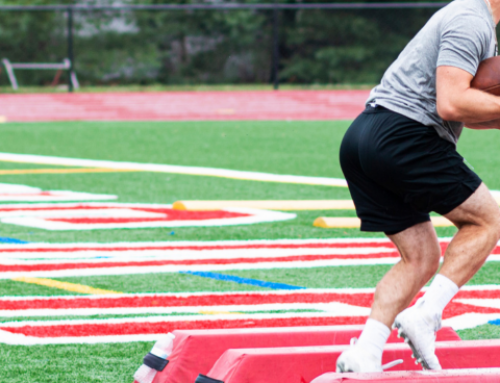3 Reasons Why Athletes Should Limit Cardio Workouts
It’s a cliché scene in nearly every sports movie you have seen since you were a kid. The tough underdog jogs into the night sporting an unimpressive gray hoodie and sweatpants while a raw beat pounds in the background.
This stereotypical scene personifies the image of hard cardiovascular training for sports that is ingrained in many athletes’ minds. While in some instances steady state cardio like this is exactly what the doctor ordered, many times it is ineffective and sometimes even detrimental.
Steady state cardio refers to a repetitive cardiovascular exercise usually done at a moderate intensity for a relatively long time. Some examples include jogging, rowing or biking at a consistent pace with little variability in intensity. This type of cardio does have its place, but with the boosts to aerobic capacity comes a barrage of problems.
Problem 1: It beats up your body
Let me take you to that high school physics class that, if you’re like me, you likely slept through. Newton’s 3rd law states: “Every action has an equal and opposite reaction.” In other words, if you push something it will push you back.
Now consider the force of a foot hitting the ground when running a long distance. That explosive force hitting repeatedly adds up over the course of miles on the road. The force when running full speed has even been calculated to be several times the force of a person’s body weight. Needless to say, it’s no wonder long-term road running wears down your joints. For athletes who already participate in high-impact sports like basketball and volleyball where repeated jumping is fundamental, the effects of high impact on the joints is accelerated and increased in magnitude.
Problem 2: It may decrease muscle mass
The second problem with steady state cardio is its propensity to cause muscle wasting when done in excess. For sports like football where size matters, the last thing you want is to break down your hard-earned muscle. Excessive cardio (over an hour a day most days of the week) can put the body in a catabolic (muscle-burning) state.
Problem 3: It’s often not specific to your sport
To get the best results on the field, training regimens should be highly sport-specific and tailor programming to movements, intensities and structures encountered on game day. Simply put power athletes should train for power, and endurance athletes should train for endurance. Some sports have very little endurance components and are termed “anaerobic” activities.
Football is a perfect example. The average play lasts between 4 and 12 seconds. In that short time players of every position must generate explosive bursts of power to run routes, block and make tackles. Long sessions of cardio do very little to simulate game day effort in a sport as explosive as football. Basketball and weightlifting are examples of sports that would also fall into this category.
How to Increase Aerobic Endurance the Right Way
Muscle wasting, joint deterioration, and lack of sport specificity must mean steady state cardio is obsolete right? Well, no. Don’t count out this staple of old-school training. Rocky Balboa wasn’t totally wrong. When done properly and in the correct circumstances this type of training does have its place. Some sports such as soccer and lacrosse require a great deal of cardiac endurance.
The long-term repetitive nature of these sports requires athletes, who are already powerful enough to kick a ball, to also possess excellent aerobic capacity. These athletes will certainly benefit from a balanced training regimen including prolonged aerobic exercise in addition to other forms of training. Even football players and weightlifters will benefit from aerobic conditioning because it helps them recover faster between plays and sets.
To combat some negative risks of this type of training athletes should ensure they take every precaution to maintain joint health and prevent muscle wasting. A quality running shoe is imperative for athletes using jogging or running as cardio training.
Also a softer surface such as the rubberized surface of a track greatly reduces the force of impact. Keeping this type of training moderate can minimize muscle wasting and joint damage. Three or four days a week, 20 to 40 mins a day is enough to build endurance, ideally done toward the beginning of a training program.
READ MORE:
- Why Pitchers Should Avoid Cardio Workouts
- 4 Cardio Workouts That Don’t Suck
- STUDY: Will Cardio Ruin Your Strength Workouts?
mixetto/iStockPhoto, Geber86/iStockPhoto
RECOMMENDED FOR YOU
3 Reasons Why Athletes Should Limit Cardio Workouts
It’s a cliché scene in nearly every sports movie you have seen since you were a kid. The tough underdog jogs into the night sporting an unimpressive gray hoodie and sweatpants while a raw beat pounds in the background.
This stereotypical scene personifies the image of hard cardiovascular training for sports that is ingrained in many athletes’ minds. While in some instances steady state cardio like this is exactly what the doctor ordered, many times it is ineffective and sometimes even detrimental.
Steady state cardio refers to a repetitive cardiovascular exercise usually done at a moderate intensity for a relatively long time. Some examples include jogging, rowing or biking at a consistent pace with little variability in intensity. This type of cardio does have its place, but with the boosts to aerobic capacity comes a barrage of problems.
Problem 1: It beats up your body
Let me take you to that high school physics class that, if you’re like me, you likely slept through. Newton’s 3rd law states: “Every action has an equal and opposite reaction.” In other words, if you push something it will push you back.
Now consider the force of a foot hitting the ground when running a long distance. That explosive force hitting repeatedly adds up over the course of miles on the road. The force when running full speed has even been calculated to be several times the force of a person’s body weight. Needless to say, it’s no wonder long-term road running wears down your joints. For athletes who already participate in high-impact sports like basketball and volleyball where repeated jumping is fundamental, the effects of high impact on the joints is accelerated and increased in magnitude.
Problem 2: It may decrease muscle mass
The second problem with steady state cardio is its propensity to cause muscle wasting when done in excess. For sports like football where size matters, the last thing you want is to break down your hard-earned muscle. Excessive cardio (over an hour a day most days of the week) can put the body in a catabolic (muscle-burning) state.
Problem 3: It’s often not specific to your sport
To get the best results on the field, training regimens should be highly sport-specific and tailor programming to movements, intensities and structures encountered on game day. Simply put power athletes should train for power, and endurance athletes should train for endurance. Some sports have very little endurance components and are termed “anaerobic” activities.
Football is a perfect example. The average play lasts between 4 and 12 seconds. In that short time players of every position must generate explosive bursts of power to run routes, block and make tackles. Long sessions of cardio do very little to simulate game day effort in a sport as explosive as football. Basketball and weightlifting are examples of sports that would also fall into this category.
How to Increase Aerobic Endurance the Right Way
Muscle wasting, joint deterioration, and lack of sport specificity must mean steady state cardio is obsolete right? Well, no. Don’t count out this staple of old-school training. Rocky Balboa wasn’t totally wrong. When done properly and in the correct circumstances this type of training does have its place. Some sports such as soccer and lacrosse require a great deal of cardiac endurance.
The long-term repetitive nature of these sports requires athletes, who are already powerful enough to kick a ball, to also possess excellent aerobic capacity. These athletes will certainly benefit from a balanced training regimen including prolonged aerobic exercise in addition to other forms of training. Even football players and weightlifters will benefit from aerobic conditioning because it helps them recover faster between plays and sets.
To combat some negative risks of this type of training athletes should ensure they take every precaution to maintain joint health and prevent muscle wasting. A quality running shoe is imperative for athletes using jogging or running as cardio training.
Also a softer surface such as the rubberized surface of a track greatly reduces the force of impact. Keeping this type of training moderate can minimize muscle wasting and joint damage. Three or four days a week, 20 to 40 mins a day is enough to build endurance, ideally done toward the beginning of a training program.
READ MORE:
- Why Pitchers Should Avoid Cardio Workouts
- 4 Cardio Workouts That Don’t Suck
- STUDY: Will Cardio Ruin Your Strength Workouts?
mixetto/iStockPhoto, Geber86/iStockPhoto












